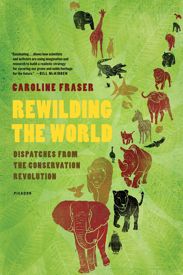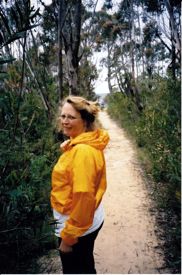Rewilding the World
Air Date: Week of January 21, 2011
 |
Biologists have been warning that we are in currently in a period of mass species extinction without a comprehensive plan to reverse this trend. Caroline Fraser, author of “Rewilding the World,” talks with Living On Earth’s Steve Curwood about how a modern technique called rewilding may be able to preserve the world’s biodiversity.
Transcript
GELLERMAN: The statistics on environmental destruction make for some gloomy reading: Species are currently disappearing a thousand times faster than before humans showed up. Nearly a quarter of all mammals are under threat – a third of all invertebrates, 70 percent of all plants. But there’s a breed of scientists and conservationists who are trying to undo the damage. Caroline Fraser chronicles their efforts in her new book “Rewilding the World.” Fraser recently spoke with Living on Earth’s Steve Curwood.
FRASER: Most of our protected areas are just way too small to protect the species within them. What we’ve done, is create these little islands of habitat which we call parks. But what we’re finding out about genetics and the needs of species in wilderness was that many critical species really need huge amounts of habitat compared to what we had set aside for them. And so Rewilding is now a method of creating much larger wilderness areas.
CURWOOD: So, when I read Rewilding, I see three words together: cores, corridors and carnivores… and that means?
FRASER: Those are the three elements that make up most rewilding projects. And the cores are these big wilderness areas that we need. The idea of cores is not really all that new, but the idea of the scale of those core areas that we need was quite new. And we also discovered that we needed to restore connections between these wilderness areas. Many of them are just too remote, too fragmented and isolated from each other, and so they’re functioning almost as islands.

Author Caroline Fraser. (Photo: Hal Espen)
And what biologists have learned about islands is that the smaller the island, the fewer species it can maintain. So we have cores, big core wilderness areas, we need corridors to connect them, or reconnect them, and we need, we’ve increasingly found carnivores, the big top predators, which actually serve to regulate ecosystems.
CURWOOD: Tell me, how is it that large carnivores are so important for rewilding?
FRASER: Well, what biologists have found is that top carnivores function to regulate the ecosystem. They control not only prey species, but also smaller predators. Michael Soulé, who is really the father of conservation biology, was quite critical in observing this. And he was observing, in his case coyotes in the chaparral ecosystems around San Diego.
If you take the coyotes out, smaller predators go hog wild. And the small predators that were doing this around San Diego were actually housecats, which were killing many different species of birds, particularly the ones that nest and feed on the ground. So, the presence of coyotes, actually acted to increase the number of birds because the coyotes were controlling the cats.
CURWOOD: How can we protect large swaths of land for wildlife, but also accommodate human needs?
FRASER: Well, that’s really the fourth “C” that they did not envision, communities. The idea is to try to create sources of income, especially through ecotourism, through guiding, and even in some case through the issuing of hunting licenses. These can be enormous sources of revenue, which can then be funneled back into communities, which encourages then local people to stay with these projects.
CURWOOD: Now, in a place like Africa, the top predators aren’t terribly popular. I’m not thinking so much of lions -- they rarely go after people. But crocodiles regularly will lie along riverbanks waiting for somebody to come for a swim or something and it’s a pretty strong ethic in Africa where “the only good crocodile is a dead one!” How do you deal with that?
FRASER: That’s an incredibly difficult issue, as I discovered. In the Okavango Delta where I spent some time with biologists who were working on a project that was designed, not only to learn about the biology of the crocodile, but they also were trying to figure out ways to convince local people to live with this very scary predator. They have finally, I think, made some progress by developing a crocodile farm that yields significant amount of revenue locally, as a way of proving that this species has a dollar value.
CURWOOD: So, describe for us the importance of the crocodile in that ecosystem.
FRASER: Well, what they’ve found is with the disappearance of many of the large crocodiles in the Okavango Delta, is that, the prey species, which in this case happens to be catfish, have really grown out of control. And that’s been really bad for many local businesses, which are based on sport fishing of other species of fish. And so what they need to do is reestablish their balance between the predator and the prey. And what that’s going to take is convincing people not to burn areas where crocodiles have their nests, not to destroy the nests and the eggs, but to allow the natural balance to reassert itself.
CURWOOD: Costa Rica has a reputation as having done extremely well in bringing back its natural environment, and really advancing conservation there. How true is that reputation, and how did they achieve it, if you do agree it has a great reputation?

FRASER: Well it does have a great reputation, in part because Costa Rica recognized so early on the value of the rainforests and the other ecosystems that it has. It’s a mixed picture however because they haven’t had enough money to invest in park rangers and protection. So Costa Rica, like many developing countries has a big problem with poaching in certain areas. But they really are an extraordinary example for the world, because they have now set aside about 25 percent of their country in protected areas. And now the push is on in finding the money to really invest in protecting these places.
CURWOOD: And what are the consequences if these projects don’t work?
FRASER: Well, the consequences are an exacerbation of what we see happening. We’re in a mass extinction event, which is being called the sixth great extinction, in which we’re seeing extinction rates skyrocket from 100 to 1,000 times the normal background rate of extinction, which is just a few species per decade. Many people are not aware of how much we rely on species that are coming out of the tropics, and for marine ecosystems. About half of the worldwide pharmaceutical market is coming from things that are derived from marine organisms. So, when we destroy these ecosystems, we’re really destroying an enormous bank of products and things that we rely on.
CURWOOD: Caroline Fraser’s book is called, “Rewilding the World: Dispatches from the Conservation Revolution.”
GELLERMAN: That’s Living on Earth’s Steve Curwood with author Caroline Fraser.
Links
Living on Earth wants to hear from you!
Living on Earth
62 Calef Highway, Suite 212
Lee, NH 03861
Telephone: 617-287-4121
E-mail: comments@loe.org
Newsletter [Click here]
Donate to Living on Earth!
Living on Earth is an independent media program and relies entirely on contributions from listeners and institutions supporting public service. Please donate now to preserve an independent environmental voice.
NewsletterLiving on Earth offers a weekly delivery of the show's rundown to your mailbox. Sign up for our newsletter today!
 Sailors For The Sea: Be the change you want to sea.
Sailors For The Sea: Be the change you want to sea.
 The Grantham Foundation for the Protection of the Environment: Committed to protecting and improving the health of the global environment.
The Grantham Foundation for the Protection of the Environment: Committed to protecting and improving the health of the global environment.
 Contribute to Living on Earth and receive, as our gift to you, an archival print of one of Mark Seth Lender's extraordinary wildlife photographs. Follow the link to see Mark's current collection of photographs.
Contribute to Living on Earth and receive, as our gift to you, an archival print of one of Mark Seth Lender's extraordinary wildlife photographs. Follow the link to see Mark's current collection of photographs.
 Buy a signed copy of Mark Seth Lender's book Smeagull the Seagull & support Living on Earth
Buy a signed copy of Mark Seth Lender's book Smeagull the Seagull & support Living on Earth

